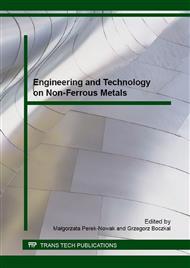p.350
p.356
p.362
p.367
p.372
p.380
p.387
p.393
p.401
Changes in Structure and Hardness of CuFe2 Alloy during Rolling with Cyclic Movement of Rolls
Abstract:
In this article, the results of microstructure and hardness investigation performed on CuFe2 alloy processed by rolling with cyclic movement of rolls (RCMR) were presented. The investigations were focused on cross section planes of deformed samples. This results were compared with the ones obtained for samples after conventional rolling. It was shown that in the initial passes, the additional movement of rolls in RCMR method generate in material heterogeneous microstructure and hardness. With increase of deformation the microstructure and hardness distribution is more homogeneous.
Info:
Periodical:
Pages:
387-392
Citation:
Online since:
February 2016
Authors:
Keywords:
Price:
Сopyright:
© 2016 Trans Tech Publications Ltd. All Rights Reserved
Share:
Citation:


